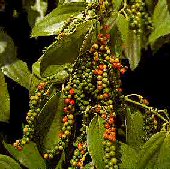 |
| Sipping Nectar through a Proboscis |
A bee flits about between 150 and 1500 flowers slurping up nectar through their hollow, elongated tube tongues. The nectar travels down the proboscis (elongated bee tongue) to one of the bees two stomachs. TWO STOMACHS! Why is it that a bee can achieve flight with two stomachs, and humans can’t even jump that high with only one stomach? Nature and her cruel jokes...
The first (honey) stomach is situated directly anterior to the second stomach and is used for the temporary storage of collected nectar. The second stomach is used for digestion. When the bee returns to the hive with a full honey stomach, she regurgitates the nectar into the mouths of 3 or more waiting bees. The recipient bees gargle with and swish around the nectar in their mouths and honey stomachs for about 20 minutes. During this time, the bee processes the nectar into honey by mixing it with the enzymes in its mouth and body.
After the bee spit-nectar churning is finished, the bee again regurgitates the severely abused nectar/honey substance. This time it is vomited up into the honeycomb, where it will undergo its final transformation. After a period of bee wing fanning to evaporate the high water content of the substance, it is the consistency of the standard honey we humans consume. The buzzing sound coming from a hive (even at night when there is no flying) is due to this "forced evaporation" process.
Honey is a natural sweeter. It is the best substitute for sugar in drinks and food. In addition to being a sweetener it is an energy booster due high concentration of glucose and fructose, which are natural fruit sugars. It is recommended to use a spoonful of raw honey eaten whole, on toast, or in coffee to eliminate lethargy, or before going to the gym. The glucose in honey gives the body an immediate energy boost due to its fast absorption, while the fructose provides more sustained energy by being absorbed slowly, giving it a healthy Glycemic Index (GI). A spoonful of honey gives you an energy buzzzzzz....
Raw Honey is Anti- M, B, V, F, S and O! Raw honey is Anti-Microbial, Bacterial, Viral, Fungal, antiSeptic, and is also an antiOxidant. It contains vitamins B1, B2, B6, C, B5 and B3 and mineral magnesium, potassium, calcium, sodium, sulphur, iron, phosphate, copper, iodine, and zinc. Honey can help combat seasonal allergies! Because pollen from local plants naturally ends up in honey, buy honey in your community for beneficial antigen immunity. For a sore throat, swallow a teaspoon of honey every few hours until symptoms resolve (antimicrobial). Use honey to dress wounds such as minor abrasions and lacerations by warming it and slathering it in and around the wound to kill bacteria and prevent infection (antibacterial and antiseptic). Us honey on cold sores to relieve pain and lessen healing time (antiviral). Instead of expensive over the counter products, use honey as a topical treatment for ringworm, athlete’s foot, and yeast infections (anti-fungal). Consuming honey on a daily basis can provide protection from the damaging effects of free radicals which contribute to heart disease, cancer, and other cardiovascular conditions (anti-oxidant). Honey also has impressive anti-inflammatory agents, speeds the repair of damaged tissue and promotes healing, calms the mind, and soothes sore muscles.
Now I get why they say “busy as a bee!” Bees are definitely the Pimps of the insect world. Male bee-pimps called Drones stay at the hive and send female bees called Workers out to buzz around collecting Nectar. While the Workers are out, Drone Pimps have massive, wild orgies with the Queen bee so she can give birth to up to 2500 of their babies, a DAY. Drone Pimp Bee Baby Daddys have a sweet deal negotiated with flowers: In return for pollinating flowers with the bits of pollen collected on the back of their legs as they travel, Workers are paid nectar. The Pimp Drone pimps nectar, ingests and regurgitates it several times, then turns it into honey. Then, the bee charges humans cash money for its product. Bulimic Bee Pimps? I think yes...
Bee Pick up Lines:
- Hey baby...puke here much?
- You have something on your stomach. No, the other one. Let me get that for you. *slap*
- Your hive or mine?
- My, what a long Proboscis you have! *wink*
- Is that your honey stomach, or are you just happy to see me?
- Pimp my Hive!
- If you’re not busy Friday, maybe we could go binge and purge together? :)
Bee Facts:
- Bees are insects. Insects are animals..they are the 4th most advanced group and cover almost 85% of the animal population..in which bees cover about 3.5% & ants 91%.
- Bees are the only insect that produces food eaten by man.
- A hive of bees will fly 90,000 miles, the equivalent of three orbits around the earth to collect 1 kg of honey.
- A colony of bees consists of 20,000-60,000 honeybees and one Queen. Worker honey bees are female, live for about 6 weeks and do all the work.
- The Queen bee can live up to 5 years and is the only bee that lays eggs. She is the busiest in the summer months, when the hive needs to be at its maximum strength, and lays up to 2500 eggs per day.
- Larger than the worker bees, the male honey bees (also called drones), have no stinger and do no work at all. All they do is mating. Authors Note: WTF? Really? FIGURES.
- The average worker bee produces about 1/12th teaspoon of honey in her lifetime.
 |
| Honey Bees in an apparent state of passing puke |










